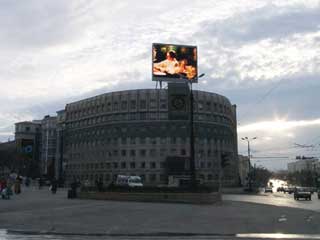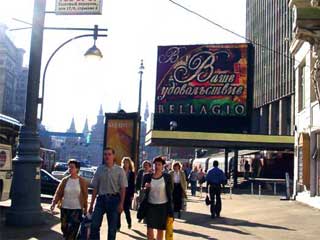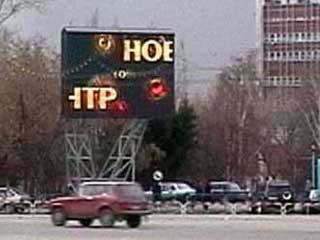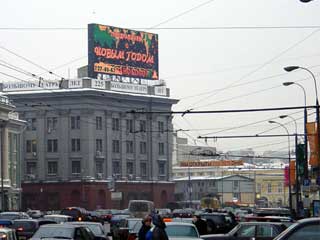Interview with chief executives of the video screen manufacturer “ATV Outdoor Systems”
To clarify some aspects related to creation and maintenance of electronic video screens recently commissioned in Krasnoyarsk (Russia) and Astana (Kazakhstan), deputy chief editor of our magazine Michael Nikulichev met with chief executives of the company-manufacturer “ATV Outdoor Systems” Boris Zaytzev, technical director, and Valery Fomin, head of the R&D department.
Will you give a brief outline of company history?
Boris Zaytzev: The core of the company consists of a team with more than 10-year experience in operating large electronic video screens (displays). At present we are all working on a new concept of creating “informational and advertising systems on the basis of electronic screens and displays”. From 1992 we started developing our own systems based on our experience in maintenance of US-made lamp screens. It took us 5 years to bring the concept to implementation stage. First full-color screens both lamp and LED manufactured by our company appeared in 1996-98. Meanwhile our team continued to install, commission and maintain video screens of various Western manufacturers in Russia: in Moscow, Barnaul, Novosibirsk, etc. Starting from 1999, we manufactured outdoor video screens in cooperation with American and Russian teams (screens in Moscow, Yekaterinburg, and Chelyabinsk).
However the need to maintain high quality standards forced us to register our own company “ATVS Alexart” (video screens in Kazakhstan and Astana) which was recently transformed into “ATV Outdoor Systems”. As a result, the whole complex of tasks related to research and development, manufacturing (both new lamp and LED screens), commissioning and even maintenance of video screens is concentrated in one specialized company, “ATV Outdoor Systems”.
Is there anything conceptually new in the video screens installed by your company?
Valery Fomin: Practically everything is conceptually new! As we have said, quality standards and convenient maintenance are our prime objectives. For this reason we are constantly upgrading and modernizing electronic modules, plastic fixtures, energy supply system, metal body and ventilation of our video screens.
 |
 |
| Large outdoor video screen in Chelyabinsk | Large outdoor video screen in Moscow |
Essentially, we have developed a unique control system that may operate both lamp and LED screens (the system that has no analogues in the world). The Krasnoyarsk video screen is unusual because for the first time we have incorporated the remote control operation and the mode for creating subtitles for the direct video broadcast in digital mode.
This is especially important for video screens installed at stadiums or concert halls. Yet another time our general concept for creating large size screens was proved right. When the video screen is meant to be seen by 5-10 or more thousand spectators, it has to differ from the one oriented towards a 30-70 people audience.
 |
 |
| Large outdoor advertizing screen in Novosibirsk | Large outdoor advertizing screen in Moscow |
Take Krasnoyarsk as an example. The outdoor video screen was installed at the stadium “Yenisey” for 10 thousand spectators for the special occasion of European Cup in Ball Hockey. We saw clearly that a large 9x12 meter screen is the optimal variant for such relatively small stadiums (5-10 thousand people). Previously, 9x12 meter video screens were quite wide spread around US stadiums. Today, our company developed similar affordable systems that became financially viable for Russian stadiums.
The outdoor video screen in Astana (Kazakhstan) also has one unique feature never tried anywhere else. We have developed and tested the system that allows conducting remote live TV and video broadcast on city outdoor video screens and control it via simple network of two PCs (Fast Ethernet) without using a separate video channel. In other words, live broadcast on any video screen may be arranged using a broad channel (even good Internet channel). All network connections proceed via TCP/IP protocol and support all Internet services of telnet, www or FTP servers.
The on-board PC is working under Unix-like operating system to enable multitask environment of simultaneous video broadcast, transfer of new data, system control and monitoring in real time. So far no other manufacturers, including Japanese and US corporations, have resolved this problem. The modern system of specialized controllers consists of PCI devices, hubs and 3-rd level controllers proper. Such modular architecture is capable of transferring huge amounts of information to electronic modules (either lamp or LED modules) and identifying and automatically compensating for any failures that may occur in the system during operation.
Amazing! Have you solved the problem that puzzled software developers around the world?
Valery Fomin: Indeed, we have. The higher you aim, the higher you jump. I guess, we were lucky, too.
What other innovations are in store?
Boris Zaytzev: Research and development is one of the main priorities for our company. However, we never talk about something that has not been accomplished. No daydreaming. We never sell plans but only real working products. There is much talk around the world of was been developed, while in fact, few of these plans ever come to fruition…
Construction of outdoor video screens is an extremely complex task that requires incorporation of the most modern achievements in electronics and digital equipment. Otherwise, Japanese and US companies would have long saturated the world with their own screens.
Any outdoor video screen is a complex product that consists of electronic modules, control system, body, electrical system etc. All of these elements have to be developed and manufactured as a single system that includes hundreds of thousands of electronic elements, dozens of kilometers of wiring, hundreds of transformers, tons of metal, hundreds of other elements. Not to lose the competition, we work on the cutting edge of electronics, computer technologies, software development, electrical and engineering innovations.
We have top class engineers and software specialists on our team. No task is too difficult for them. For ten years they have been proving their highest qualification by installing state-of-the-art outdoor video screens in regions with extremely diverse climate. It may be worth to mention that we always help to train local specialists and maintenance personnel and offer our support and advice even after the warranty period.
What other companies work in this area?
Boris Zaytzev: There is always competition in the market. But it is not proper for me to make comments on our competitors. We were never afraid of honest competition. Unfortunately, at present Russian market conditions remind many people of Chicago in 1930ies. So, we learnt how to survive even in conditions that can hardly be called civilized. But we are not here to make judgments like that.
Will you at least describe some what you have to encounter in the market?
Boris Zaytzev: In general there are three main approaches to developing outdoor electronic screens:
- Large diverse corporations that work with new lamp and LED technologies (there no more than 10 such companies in the world);
- Specialized companies that have developed some unusual device or system that gives them a marketing edge (there are about 50 such companies);
- Companies that do not develop anything new but are satisfied with cloning of other companies’ products, frequently without license (there are more than 500 such companies).
The first group includes such powerful players in the USA and Canada as Daktronics. I don’t want to boast but there is only one Russian company that manufactures new lamp and LED screens and that can be included in the first group: “ATV Outdoor Systems”. However, there are very few companies like ours who possess both lamp and LED technology. Moreover, there no more than seven companies in the world who managed to manufacture and install large video screen systems of 9x12 meters and more.
The second group is more numerous. It includes a number of Japanese corporations that are not much known outside Japan and South East Asia. The Western firms include Sacco (Canada), Lighthouse (believed to be of UK origin though in fact operating out of Hong-Kong and China). There are several dozens of such companies. In Russia there are two sister companies worth mentioning: Araneus and Nata-Info (Yoshkarala). In the area of mid-sized (5x6 meters) and mobile screen systems they are strong competitors to any Canadian or US company.
The third group is densely populated by companies of various sizes with various technical capabilities. However, their products are frequently not licensed, carry no innovative technology and are generally not very reliable. However, the competition is fierce and you have to stand on your toes to keep your market niche and not be downgraded to the third group. Our company has to operate in fairly difficult conditions because we manufacture outdoor video screens of different types and sizes and have to compete with serious “heavyweights”.
We understand only too well how much work and effort stands behind any new technological development in this area, and treat all our competitors with due respect.
What future tendencies you can identify?
Boris Zaytzev: The following trends seem to be the most advantageous:
- electronic video screens of sizes larger than 6x8 meters;
- mobile screen systems;
- upgrade of electronic modules (for both lamp and LED video screens), control systems with the idea of constantly improving price/quality and price/reliability ratio. All this will make electronic screens affordable to larger number of potential buyers.
The area of electronic outdoor video screens is a dynamically growing industry. There are already many players and many who would wish to join. But only professional and devoted teams like ours are capable to stay in the game.





